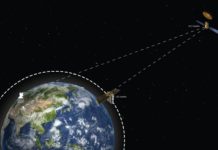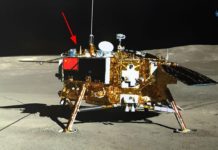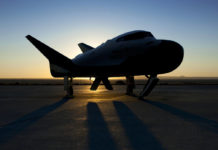While almost everyone has their eyes set on Mars as the next destination for Humans in space, the truth is that we should probably not send people there (read why here). Look further and meet Titan, Saturn’s largest moon, which is likely the most inviting place for us beyond Earth.
Meet Titan
Titan was discovered in 1655 by the Dutch astronomer Christiaan Huygens who first named it Saturni Luna (or Luna Saturni, Latin for “Saturn’s moon”). The name Titan, and the names of all 7 satellites of Saturn then known (62 known moons now), came from John Herschel in 1847. He suggested the names of the mythological Titans, brothers and sisters of Cronus, the Greek Saturn and patron of the harvest.
Titan has a diameter of 5151 km and is the second largest moon of the Solar System after Jupiter’s Ganymede (5270 km of diameter). It’s actually larger than one of our planets, Mercury (4880 km) and not so much smaller than Mars (6780 km). Titan orbits at 1.2 million km from Saturn, which itself orbits at 1.5 billion km from the Sun. By comparison Earth and Mars orbit respectively at 150 million km and 225 million km from the Sun. Saturn (and Titan) takes 30 years to orbit the Sun, and Titan needs 16 Earth days to complete a full rotation on itself with regards to the Sun, so a year and a day on Titan lasts respectively 30 Earth years and 16 Earth days.
Watch the Titan touchdown by the Huygens lander on Jan. 14, 2005, as the most distant landing ever on another world, and the only landing on a body in the outer solar system. The video below uses actual images taken by the probe during its two-and-a-half hour fall under its parachutes:
Titan’s gravity is 14% of Earth gravity (the Moon is 16.5% and Mars 37.6%), meaning someone weighing 100 kg will feel on Titan what someone hypothetically weighing 14kg would feel on Earth.
It is also the only moon in the Solar System known to have a dense atmosphere, 4.5 denser than Earth’s atmosphere. Its atmospheric pressure is actually the second highest for a body with a surface in the Solar System (excluding the 4 gas giants), after Venus and before Earth! (Warning : one should not confuse density of the air (calculated in kg of matter per cubic meter of air) and atmospheric pressure (calculated in Newton per square meter, as the weight of a column of air exerted on a given surface, at sea level for instance). Next in line is Mars with an atmospheric pressure of a mere 0.6% of Earth’s! (Compared to 145% for Titan and 9200% for Venus). On Titan, you’d feel the same pressure on your skin as when at the bottom of a pool on Earth, below 5 meters of water. We’ll see further below how much of an advantage such a dense atmosphere is when compared to Mars !
The average temperature at the surface is of −179.5 °C. Yes, it’s cold, but it’s not a show-stopper as we’ll see below.
Thanks to its atmosphere, Titan has weather with a methane cycle of evaporation and condensation, leading to clouds, rains, rivers and seas. Titan has long droughts and big storms. And because of the angle between Titan’s rotational axis and the orbital plane, Titan even has seasons!
Titan is indeed the only object in space other than Earth where clear evidence of stable bodies of surface liquid has been found: it has a handful of seas, and hundreds of lakes and rivers of liquid methane and ethane. Its largest sea Kraken Mare located in the northern polar region is 1,170 km long with depths estimated at 300 m and is named after The Kraken, the Norse sea monster. Titan’s crust is made of water ice and near its equator it also has mountains made of water ice, with Mithrim Montes culminating at 3,337 m. At the equator as well, gigantic dunes sit atop ice. Instead of being made of sand, the dunes are likely piles of complex organic compounds called hydrocarbons, more viscous than sand, that were made in the atmosphere due to the reaction of other hydrocarbons and sunlight. Think of it as very small pellets of plastics. These dunes actually cover 20% of Titan’s surface, and can be hundreds of km long, 1-2 km wide, and 150 m high. Titan is even believed to have a global subsurface liquid water ocean, which may be 100 to 200 km thick, located below the surface ice crust estimated to be 50 to 150 km thick.








So your main argument for not landing on Mars was because we might contaminate the surface with extremophile microbes….
And your main argument for landing on Titan is that we can walk around on the surface. Presumably while spilling microbes around everywhere.
Consistency is important when reasoning.
This isn’t a convincing argument,just as the anti-Mars argument wasn’t.
You can’t base an entire argument on planetary protection and then follow up with a second article that doesn’t even mention contamination.
Hi, you’re a bit unfair with me, I mentioned on page 2, points 14 “Possibility to study potential Titan life without the risk of harming it as it would be very different from Earth life” Issue with Mars is that we have many ideas of surface habitats where Earth life could possibly survive and even metabolize, which is a very different situations from Titan where, because of the temperature, -179°C, life would necessary be very different and alien to us. So the risk of contamination isn’t the same at all, we’re talking of 2 different extremes here. See this article :”below -20 °C, single-celled organisms dehydrate, sending them into a vitrified – glass-like – state during which they are unable to complete their life cycle. The researchers propose that, since the organisms cannot reproduce below this temperature, -20 °C is the lowest temperature limit for life on Earth.
(see https://phys.org/news/2013-08-lowest-temperature-life.html#jCp)
Also, about back-contamination, “it may seems unlikely that life adjusted to Titan habitats could survive on Earth. The reasoning would be that any life that works at such low temperatures must use much faster reactions than our biochemistry (unless it lives at a glacial pace). So when you warm it up, it’s likely to self destruct.” says Robert Walker
Titan is currently categorized as “Provisional category II” with “only a remote chance that contamination from Earth could jeopardize future exploration”.
There category II is the same as our Moon. But it is provisional because they say that more research is needed.
“Titan would surely be studied robotically first. There are no serious proposals to send humans there right away, unlike Mars. So, unless there is some drive to send humans there quickly, we’d probably answer all those planetary protection questions already before we land humans there, just in the natural course of solar system exploration. If so, and if the results turn out favourable, it may well turn out to be one of the best place for a human colony outside of Earth. It would be a fun place to live in some ways, with the human powered flight, for instance, and the intriguing seas. And it might potentially be a biologists’ paradise if there is indeed native Titan life to study.”
Also, Phobos has significantly lower gravity than Titan, has the lowest altitude libration point in the solar system, meaning that landing there is significantly easier than Titan. Much easier to orbit and stationkeep too.
Additionally, Mars when viewed from Phobos fills the entire sky. the great view from Titan doesn’t stand up to scrutiny either.
If anything, Phobos then Mars is the best route (Lockheed Martin agrees).
Also, just remind us, how long does it take to get to Titan? That’s quite an important point. Surprised it wasn’t addressed in more detail.
3 or 4 years to Titan is better than 9 months to Mars?
I said it was the easiest body to land on…out of the 10 largest bodies with a surface in our Solar System, so not considering Phobos here.
Defining what’s best is subjective anyway, depends on the criterias. Phobos has no atmosphere so people wuld be exposed to harmful solar and galactic radiations, unlike on Titan, that’s a major issue.
Distance IS the major issue, I made it clear : age 2? point 13 : “It’s arguably the cheapest place beyond Earth to build a settlement…Leaving aside the cost of getting there, which, true, is not small. Titan will be cheaper than anywhere else thanks to the thick atmosphere and not having to pressurize habitats, same for suits to wear to go outside.”
Mentioned distance again in the list of objections page 3 : “It’s far, it took 7 years for Cassini-Huygens to reach Titan. Yes, but with faster propulsion, in particular Nuclear Electric Propulsion, it should be possible to shorten the trip to 2 years, maybe even 1 year. Here, I recommend people follow closely Ad Astra’s efforts with their VASIMR engine, the most advanced form of plasma propulsion nearing completion to date, and the Kilopower Project by NASA for the electricity power generation.”
Anyway, true, we’re doing very long term thinking here 😉 but the outer solar system and even any Earth-MArs economy will only flourish once we have Nuclear Electric Propulsion, and when we do, Titan will become accessible.
Another objection one could make : what is it with that “planetery chauvinism” as Car Sagan put it ? That is why that obsession with colonizing celestial body when we can make our own freespace colony using matter from the asteroids belt, there’s enough matter there to create thousands of times the surface area of the Earth in habitable space in freespace, in huge rotating stations where to reproduce our gravity, climate, atmospheric pressure, powered with the unlimited energy from the Sun, could be done close to Earth! you can Gerard O’Neill’s THe High Frontier to know mroe about it ! 🙂
In the section — It will be hard for a rocket using retropropulsion to land on a body whose crust is made of water ice. — You quote Russel Borogove as saying, “Fairly little of the surface will be disturbed to begin with. The exhaust gas will be relatively tenuous, and it will disperse rapidly in vacuum, so it will only transfer a small amount of heat to the surface in the few seconds of landing.” While I cannot dispute this, does “dispersed rapidly in vacuum” even apply to Titan? It has an atmosphere that is 50% more dense than Earth, thus NOT a vacuum.
We saw how little dust was kicked up from the surface of the moon during the lunar landings, but that was for a very small craft designed to support two human lives for a few days at most. Assuming that any vehicles landing on Titan with the supplies needed for long-term habitation or colonization would be much heavier, this will require a longer and/or more intense retropropulsion burn than the LEM. Sure, NASA’s videos of the Huygens lander did not appear to show any issues, but it only had a mass of 852 pounds. This is far less than any craft that will be carrying enough supplies to support long term human life on Titan.
“The exhaust gas will be relatively tenuous, and it will disperse rapidly in vacuum”
But there is a dense nitrogen atmosphere?
Fix Earth first
Re: #1, Titan also is protected by Saturn’s Earth-comparable magnetosphere 95% of the time.